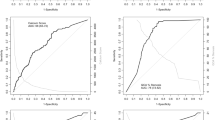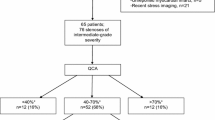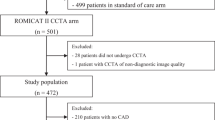Abstract
The new methods for diagnosing the ischemia with coronary computed tomographic angiography (CTA) as a noninvasive test have been investigated. To compare the relative plaque volume to quantitative CTA and quantitative coronary angiography (QCA) for detecting flow-limiting coronary artery stenoses. We studied 49 patients with 55 intermediate lesions (30–69% diameter stenosis) who underwent CTA, coronary angiography (CAG), and FFR. CTA and QCA measures included lesion length, percent diameter stenosis (%DS), minimal lumen diameter (MLD), target main vessel percent plaque volume (%PV), lesion %PV, target main vessel percent lumen volume (%LV), and lesion %LV. FFR ≤0.80 was considered diagnostic of a flow-limiting lesion. The area under the receiver-operating characteristic curve (AUC) was used to determine the accuracy of detecting flow-limiting lesions. We also investigated the AUC of discrimination of flow-limiting lesion according to calcium score. Eighteen of 55 lesions (32.7%) had an FFR ≤0.80. Only vessel %PV differentiated between lesions with and without flow obstruction (67.6 vs. 62.7%, p = 0.018). The AUC for vessel %PV was greatest (0.76; 95% CI 0.61–0.87). The AUC for the discrimination of the flow-limiting lesions according to low calcium score (≤400) improved to 0.82 (95% CI 0.57–0.94). In intermediate coronary artery stenoses, vessel %PV is more accurate than conventional stenosis assessment for detecting flow-limiting lesions. In low calcium score, vessel %PV is more useful for diagnosis of ischemic heart disease compared with conventional quantitative measures.








Similar content being viewed by others
References
Tonino PA, De Bruyne B, Pijls NH, Siebert U, Ikeno F, van’t Veer M et al (2009) Fractional flow reserve versus angiography for guiding percutaneous coronary intervention. N Engl J Med 360:213–224
De Bruyne B, Pijls NH, Kalesan B, Barbato E, Tonino PA, Piroth Z et al (2012) Fractional flow reserve-guided PCI versus medical therapy in stable coronary disease. N Engl J Med 367:991–1001
Ko BS, Cameron JD, Leung M, Meredith IT, Leong DP, Antonis PR et al (2012) Combined CT coronary angiography and stress myocardial perfusion imaging for hemodynamically significant stenoses in patients with suspected coronary artery disease: a comparison with fractional flow reserve. JACC Cardiovasc Imaging 5:1097–1111
Rochitte CE, George RT, Chen MY, Arbab-Zadeh A, Dewey M, Miller JM et al (2014) Computed tomography angiography and perfusion to assess coronary artery stenosis causing perfusion defects by single photon emission computed tomography: the CORE320 study. Eur Heart J 35:1120–1130
Choi JH, Min JK, Labounty TM, Lin FY, Mendoza DD, Shin DH et al (2011) Intracoronary transluminal attenuation gradient in coronary CT angiography for determining coronary artery stenosis. JACC Cardiovasc Imaging 4:1149–1157
Min JK, Leipsic J, Pencina MJ, Berman DS, Koo BK, van Mieghem C et al (2012) Diagnostic accuracy of fractional flow reserve from anatomic CT angiography. JAMA 308:1237–1245
Nakazato R, Shalev A, Doh JH, Koo BK, Gransar H, Gomez MJ et al (2013) Aggregate plaque volume by coronary computed tomography angiography is superior and incremental to luminal narrowing for diagnosis of ischemic lesions of intermediate stenosis severity. J Am Coll Cardiol 62:460–467
Park HB, Heo R, o Hartaigh B, Cho I, Gransar H, Nakazato R et al (2015) Atherosclerotic plaque characteristics by CT angiography identify coronary lesions that cause ischemia: a direct comparison to fractional flow reserve. JACC Cardiovasc Imaging 8:1–10
De Bruyne B, Hersbach F, Pijls NH, Bartunek J, Bech JW, Heyndrickx GR et al (2001) Abnormal epicardial coronary resistance in patients with diffuse atherosclerosis but “Normal” coronary angiography. Circulation 104:2401–2406
Valentin J (2007) Managing patient dose in multi-detector computed tomography(MDCT). ICRP Publication 102. Ann ICRP 37:1–79
Papadopoulou SL, Neefjes LA, Garcia-Garcia HM, Flu WJ, Rossi A, Dharampal AS et al (2012) Natural history of coronary atherosclerosis by multislice computed tomography. JACC Cardiovasc Imaging 5:S28–S37
MacCarthy P, Berger A, Manoharan G, Bartunek J, Barbato E, Wijns W et al (2005) Pressure-derived measurement of coronary flow reserve. J Am Coll Cardiol 45:216–220
Pijls NH, Van Gelder B, Van der Voort P, Peels K, Bracke FA, Bonnier HJ et al (1995) Fractional flow reserve. A useful index to evaluate the influence of an epicardial coronary stenosis on myocardial blood flow. Circulation 92:3183–3193
Budoff MJ, Dowe D, Jollis JG, Gitter M, Sutherland J, Halamert E et al (2008) Diagnostic performance of 64-multidetector row coronary computed tomographic angiography for evaluation of coronary artery stenosis in individuals without known coronary artery disease: results from the prospective multicenter ACCURACY (Assessment by Coronary Computed Tomographic Angiography of Individuals Undergoing Invasive Coronary Angiography) trial. J Am Coll Cardiol 52:1724–1732
Voros S, Rinehart S, Qian Z, Joshi P, Vazquez G, Fischer C et al (2011) Coronary atherosclerosis imaging by coronary CT angiography: current status, correlation with intravascular interrogation and meta-analysis. JACC Cardiovasc Imaging 4:537–548
Rodes-Cabau J, Gutierrez M, Courtis J, Larose E, Dery JP, Cote M et al (2011) Importance of diffuse atherosclerosis in the functional evaluation of coronary stenosis in the proximal-mid segment of a coronary artery by myocardial fractional flow reserve measurements. Am J Cardiol 108:483–490
Gould KL, Johnson NP, Bateman TM, Beanlands RS, Bengel FM, Bober R et al (2013) Anatomic versus physiologic assessment of coronary artery disease. Role of coronary flow reserve, fractional flow reserve, and positron emission tomography imaging in revascularization decision-making. J Am Coll Cardiol 62:1639–1653
Zeiher AM, Schachlinger V, Hohnloser SH, Saurbier B, Just H (1994) Coronary atherosclerotic wall thickening and vascular reactivity in humans. Elevated high-density lipoprotein levels ameliorate abnormal vasoconstriction in early atherosclerosis. Circulation 89:2525–2532
Park MJ, Jung JI, Choi YS, Ann SH, Youn HJ, Jeon GN et al (2011) Coronary CT angiography in patients with high calcium score: evaluation of plaque characteristics and diagnostic accuracy. Int J Cardiovasc Imaging 27(Suppl 1):43–51
Motoyama S, Kondo T, Sarai M, Sugiura A, Harigaya H, Sato T et al (2007) Multislice computed tomographic characteristics of coronary lesions in acute coronary syndromes. J Am Coll Cardiol 50:319–326
Motoyama S, Sarai M, Harigaya H, Anno H, Inoue K, Hara T et al (2009) Computed tomographic angiography characteristics of atherosclerotic plaques subsequently resulting in acute coronary syndrome. J Am Coll Cardiol 54:49–57
Okazaki S, Yokoyama T, Miyauchi K, Shimada K, Kurata T, Sato H et al (2004) Early statin treatment in patients with acute coronary syndrome: demonstration of the beneficial effect on atherosclerotic lesions by serial volumetric intravascular ultrasound analysis during half a year after coronary event: the ESTABLISH Study. Circulation 110:1061–1068
Nicholls SJ, Ballantyne CM, Barter PJ, Chapman MJ, Erbel RM, Libby P et al (2011) Effect of two intensive statin regimens on progression of coronary disease. N Engl J Med 365:2078–2087
de Graaf MA, Broersen A, Kitslaar PH, Roos CJ, Dijkstra J, Lelieveldt BP et al (2013) Automatic quantification and characterization of coronary atherosclerosis with computed tomography coronary angiography: cross-correlation with intravascular ultrasound virtual histology. Int J Cardiovasc Imaging 29:1177–1190
Acknowledgements
This research did not receive any specific grants from funding agencies in the public, commercial, or not-for-profit sectors.
Author information
Authors and Affiliations
Corresponding author
Ethics declarations
Conflict of interest
We declare that all authors have no conflict of interest.
Ethical approval
All procedures performed in studies involving human participants were in accordance with the ethical standards of the institutional research committee and with the 1964 Helsinki declaration and its later amendments or comparable ethical standards.
Informed consent
Informed consent was obtained from all individual participants included in the study.
Rights and permissions
About this article
Cite this article
Kato, N., Kishi, S., Arbab-Zadeh, A. et al. Relative atherosclerotic plaque volume by CT coronary angiography trumps conventional stenosis assessment for identifying flow-limiting lesions. Int J Cardiovasc Imaging 33, 1847–1855 (2017). https://doi.org/10.1007/s10554-017-1186-z
Received:
Accepted:
Published:
Issue Date:
DOI: https://doi.org/10.1007/s10554-017-1186-z




